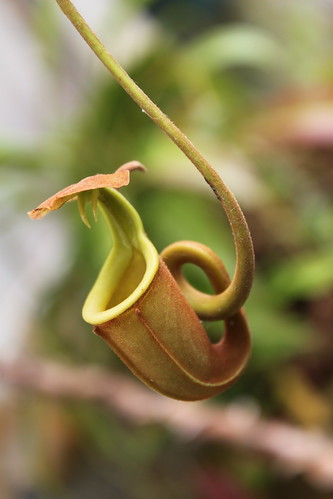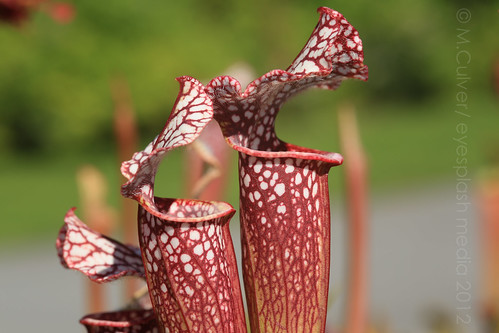Killer Plants
Some carnivorous plants are like mazes that lead to a dead end. Some are like ticking time bombs. Others, just swallow creatures whole. When I first started researching about carnivorous plants, I thought I already knew a lot about them. It turns out that while I am learning about these plants, I can’t stop thinking about them because there is a lot more to be discovered. Imagine a fascinating, beautiful plant living in a boggy swamp and getting its nutrients not only from soil, but mostly… from meat! Dun, dun, dun!
There are 630 different kinds of carnivorous plants around the world. Some carnivorous plants are aquatic and others live in the soil like most other plants do. They live in poor, wet soil that doesn’t have a lot of nutrients. Because the soil doesn’t give them the nutrients they need, they’ve adapted by eating bugs or small animals. Carnivorous plants are divided in five types, according to how they can catch their prey (food): Pitfall Trap, Flypaper Trap, Snap Trap, Bladder Trap and Lobster Trap.
The Pitfall Trap plants have slippery leaves that are shaped like a funnel and slant down toward their bottom. When bugs land on the leaves of these plants, they slide down the leaf into a “pool” of digestive enzymes found in the bottom of the leaf. Monkey Cup and some bromeliads are examples of Pitcher plants and some are so large that they can catch and consume rats or frogs.
Pitcher Plants have a mechanism that they can turn on and off throughout the day. Part of the day, the Pitcher Plant’s edges are dry so when a scout ant comes and smells the nectar, it goes back to its colony and brings some of its friends. But by that time, the plant is wet and the ants fall into it. The Pitcher Plant gets an ant feast! If the Pitcher Plant was wet all the time, the one scout ant would slide down and not go back to the colony to bring the other ants, which means that it wouldn’t bring back all the food. Insects cannot escape Pitcher Plants, with their pitfall hunting mechanism.
When bugs land on a Flypaper Trap carnivorous plant, the sticky substance that appears to be dew when it sparkles on the sun keeps bugs from being able to get away. When the bug struggles to escape, it gets even more stuck and the enzymes on the plant’s leaf digest it faster. Flypaper Trap plants are impossible to escape. Sundew and Butterwort are a couple of carnivorous plants in this category.
Carnivorous plants with Snap Traps catch their food by trapping bugs or small animals inside their leaves so they cannot escape. All of you might have heard of the Venus Flytrap, but did you know that if the prey touches one of the hairs on the leaf it will set a timer? If it touches another hair within 20 seconds, then the plant will shut; otherwise, the prey will be safe. You can probably make a Venus Flytrap close its jaws with a stick, but it has to feel the prey struggling to start its digestive process. If the object isn’t food, the trap will reopen in about 12 hours and “spit” it out. The Venus Flytrap can only close its mouth six times in its lifetime.
After capturing an insect or animal, The Venus Flytrap shuts in less than a second. “All of this takes about 1/2 second,” says Julia Cooke, a plant ecologist from the Hawkesbury Institute for the Environment at the University of Western Sydney, in Australia. But other carnivorous plants can move even faster: “The related Waterwheel Plant uses snap-traps, but underwater. This plant closes its traps in 20 milliseconds, making it one of the fastest movements recorded in plants.”
Carnivorous plants with Bladder Traps, like the Bladderworts and the Pinguicula, live in the water. They suck bugs and other small animals out of the water (like a vacuum cleaner)and into the bladder so they can be digested. There is no escape.
Carnivorous plants with Lobster Traps use tiny hairs which are all going the same direction to force bugs to walk toward the bottom of the plant’s leaves. The Cobra Lily and the Corkscrew are types of Lobster Trap plants. There are mazes inside them that are easy to enter but hard to leave that they use to catch prey. When the bugs hit a “dead end” with a pool full of digestive enzymes, they can’t escape.
I never knew that carnivorous plants were so interesting and that they were divided in five categories based on how they eat bugs and animals. They are beautiful but dangerous, inviting but deadly. Not to humans though, so don’t be scared if you see one in action. I hope you do.






WOW! Fascinating subject and very well researched. The result is an easy-to-read article, full of interesting facts. I specially like the videos you used to illustrate and enrich your article. Excellent job!
What an interesting article! I have heard of Venus Fly Traps, but I never knew there were so many different types of plants that actually eat. I bet this was a lot of fun to do research on! Great job, Noah!
Noah,
What an interesting article you wrote! I have never seen a carnivorous plant. Have you? Those are great pictures you gathered. Thanks for sharing your blog.
I really enjoyed reading your blog about carnivorous plants, Noah! I had no idea that there where so many “killer plants” in the world! I also was surprised to learn about the 5 different types of carnivorous plants. Your article was so well written, and it was organized to make it easy to follow. It was a pleasure to read! Thank you for sharing this interesting information. I hope we can find a few carnivorous plants during our travels.
I like your topic. It was very intresting. I never knew that pitcher plants turn make themselves wet dry and wet. I like it a lot.